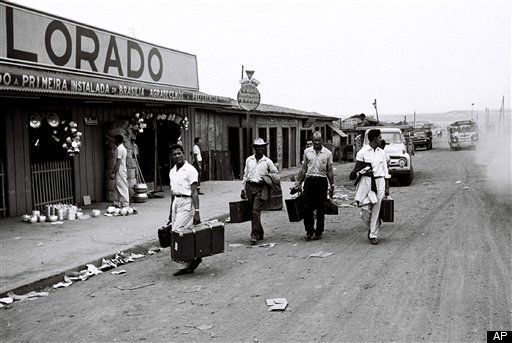
I have always wanted to visit Brazil, but after reading Contemporary Urbanism in Brazil: Beyond Brasília I am discouraged about doing so. What once might have been a quick trip, perhaps an eco-tourism tour on the Amazon followed by a few days in Rio, would now need to be an extended sojourn of several weeks to visit half a dozen or more great Brazilian cities. I don't know if I could swing that.
The book, edited by Vicente del Rio and William Siembieda, both of California Polytechnic State University, San Luis Obispo, is a stimulating collection, well illustrated, of articles by Brazilian planners and architects concerning not only contemporary urbanism in their country, as the book's title indicates, but also the history that resulted in the urbanism there that is now "contemporary."
The book is divided into three parts. The first ("Late Modernism: The Struggle to Control City Form and Function") considers the legacy of modernism, which was adopted wholesale in Brazil starting in the late 30s. The second part ("Revitalization: The Struggle to Make the Best of the Existing City") considers the reaction to modernism, which primarily took the form of projects based on the preservation of the pre-modern urban heritage. This reaction began in the 60s and 70s, but really got going with the return to democracy in the 80s. The third part of the book ("Social Inclusion: The Struggle to Make a Better City for the Community") considers current efforts to make Brazilian cities better serve the entire urban population including, especially, the masses of urban residents who live in favelas or other irregular settlements.
If only for the planned capital of Brasília, which was only one of several planned modernist cities in Brazil, Brazil would be famous for modernist urbanism. The fascination with modernism, however, went far beyond the building of new cities. Modernism came to Brazil in the 20s but it became well-established in the 30s as part of the Estado Novo ("new state") of the populist dictatorship of Getúlio Vargas. (Vargas in the early 30s built Goiânia, a planned capital for the State of Goiás that employed modernist principles). Modernism then fit well with the centralized state that arose after the military coup in 1964.
The forms of modernist architecture were pervasive, at all income levels. At the bottom, planners destroyed squatter settlements and sent their residents to modernist public housing far from the city. At the top, the upper classes, later imitated by the middle classes, accepted with enthusiasm living in "towers in the park" -- especially if the "park" was privatized and gated, and shopping occurred in shopping centers cut off from the street. (These points are discussed extensively in articles in the book about the "vertical cityscape" in São Paolo and how shopping centers have shaped the Brazilian city.)
One of the lessons of this history is that architecture and what is called "urban design" are devoid of political or moral content, notwithstanding a lot of rhetoric to the contrary. At the same time that modernism was being sold as progressive by architects fleeing persecution in Germany, it was being adopted by authoritarian regimes in places like Brazil. As co-editor Vicente del Rio writes in his introduction, the military regime in Brazil embraced modernism because the "military would welcome the efficiency, functionalism, and technocracy of modernism; its urbanism of segregated land uses; its emphasis on private vehicles; its grandiose public works, and its role in promoting the growing gap between the rich and poor. Given its authoritarian and functionalist nature, modernist urbanism was well suited to the new power structure."
Prof. del Rio goes on to say that modernist urbanism well served the regime because of "its authoritarian and functionalist nature," but while modernism certainly served the regime, there is no reason to believe that modernism itself -- its "nature" -- is inherently authoritarian and functionalist, or at least any more authoritarian and functionalist than other forms of architecture, such as traditional or classical architecture, which might just as well be said to have "served well" other authoritarian movements in the 20th century.
Buildings are physical objects. They are not human beings and are not moral or immoral, leftist or rightist.
What was morally, politically and (ultimately) economically bankrupt was the authoritarian military regime, which left to Brazil's new democracy in the 80s a catastrophic urban situation. In reaction, the new democratic government adopted what Professors del Rio and Siembieda define as a "postmodern" urbanism that was pluralistic with respect to social values and morphologies, and more participatory, all for the goal of producing socially just cities.
I will consider this postmodern urbanism in Part 2 of this review, next week.
Frank Gruber writes a weekly column on local politics, which often involve land use issues, for the Santa Monica Lookout News, a news website. His first book, Urban Worrier: Making Politics Personal, was published by City Image Press.